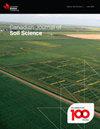How Does No-till Affect Soil-Profile Distribution of Roots?
IF 1.5
4区 农林科学
Q4 SOIL SCIENCE
引用次数: 0
Abstract
No-till (NT) often causes prominent stratification of C and nutrients in the soil profile relative to tilled systems. We hypothesize differences in root distribution within the soil profile between NT and tilled systems could be one factor contributing to stratification. We evaluated how NT affects root length density (RLD), root biomass yield (RBY), and root diameter compared with other tillage systems and factors that may affect root characteristics. We reviewed studies until 23 January 2024 where RLD, RBY, or root diameter were reported under NT and tillage. The data on RLD, RBY, and diameter were tabulated and the weighted log response ratio (MLRR) and confidence intervals computed. Our meta-analysis showed NT increased RLD in the 0-10 cm depth, but reduced RLD at 10-20 cm. It increased RBY and diameter in the 0-20 cm depth and reduced both characteristics at 20-30 cm. Regardless of root characteristic, NT had mixed effects below 30 cm. However, across the soil profile (minimum 50 cm depth), NT had no effect on RLD and RBY. No-till-induced changes in roots can be related to increased compaction at the tillage interface. No-till stratified both RLD and RBY compared with high intensity tillage systems, although there were some conditions where NT stratified only RLD or RBY. No-till did not induce stratification of RLD and RBY in dry regions, mild or hot climates, in medium-textured soils, or compared with intermediate intensity tillage systems. Overall, NT can result in stratification of both RBY and RLD compared with high intensity tillage systems.免耕如何影响根系在土壤中的分布?
相对于翻耕系统,免耕(NT)通常会导致土壤剖面中的碳和养分明显分层。我们假设,免耕和耕作系统之间根系在土壤剖面中分布的差异可能是造成分层的一个因素。与其他耕作制度和可能影响根系特征的因素相比,我们评估了氮肥如何影响根系长度密度(RLD)、根系生物量产量(RBY)和根系直径。我们查阅了截至 2024 年 1 月 23 日的研究报告,其中报告了氮肥和耕作下的根长密度、根生物量产量或根直径。我们将 RLD、RBY 和直径数据制成表格,并计算了加权对数反应比 (MLRR) 和置信区间。我们的荟萃分析表明,在 0-10 厘米的深度,定向培育增加了 RLD,但在 10-20 厘米的深度,RLD 减少了。在 0-20 厘米深度,NT 增加了 RBY 和直径,而在 20-30 厘米深度,这两个特性都有所降低。无论根的特性如何,NT 在 30 厘米以下的影响不一。不过,在整个土壤剖面(最小深度 50 厘米)上,NT 对 RLD 和 RBY 没有影响。免耕引起的根系变化可能与耕作界面的压实增加有关。与高强度耕作系统相比,免耕对 RLD 和 RBY 都有分层作用,但在某些情况下,免耕只对 RLD 或 RBY 有分层作用。在干旱地区、温和或炎热的气候条件下,在中等质地的土壤中,或与中等强度的耕作系统相比,免耕不会导致 RLD 和 RBY 分层。总体而言,与高强度耕作系统相比,免耕可导致 RBY 和 RLD 分层。
本文章由计算机程序翻译,如有差异,请以英文原文为准。
求助全文
约1分钟内获得全文
求助全文
来源期刊

Canadian Journal of Soil Science
农林科学-土壤科学
CiteScore
2.90
自引率
11.80%
发文量
73
审稿时长
6.0 months
期刊介绍:
The Canadian Journal of Soil Science is an international peer-reviewed journal published in cooperation with the Canadian Society of Soil Science. The journal publishes original research on the use, management, structure and development of soils and draws from the disciplines of soil science, agrometeorology, ecology, agricultural engineering, environmental science, hydrology, forestry, geology, geography and climatology. Research is published in a number of topic sections including: agrometeorology; ecology, biological processes and plant interactions; composition and chemical processes; physical processes and interfaces; genesis, landscape processes and relationships; contamination and environmental stewardship; and management for agricultural, forestry and urban uses.
 求助内容:
求助内容: 应助结果提醒方式:
应助结果提醒方式:


